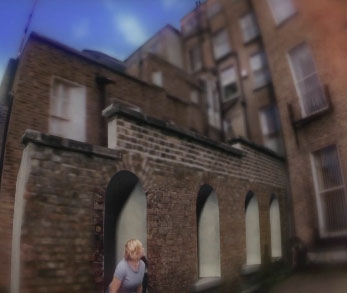
Click image to view the video.
(best for broadband)
A 3-D Computer Animation by
Ronan Coyle - animation
Jim McGuinness – photography
Giles Packham – music
Windows Media player required.
Get it by clicking the icon below.
About Phantom
Cast
The Girl – Catherine Bruen
The Guy – Ronan
Coyle
Awards
In 2003 James Kelly, came on board as executive producer to submit Phantom to a number of Irish film festivals. Phantom was shown in competition 2003, at the Galway Film Fleadh, where it won third place in Best Animation; and at the Kerry Film Festival, where it won commendation for Best Animation Technique and, from the director Neil Jordan, the adjudicator, Special Commendation for Best Director.
Creative Process
For about ten years, Ronan Coyle shared a flat in the house in Merrion Square with various flatmates.
In early 2002, an eviction notice arrived.
The three friends, Ronan, Jim, and Giles, having talked about doing a collaboration, thought the flat would be appropriate, and they waited until most of the rooms were empty.
Giles had already written the music.
Early one day, the three met in the flat and listened to the music over and over and discussed what would happen in the film.
The dripping theme was inspired by various upstairs events over the years of overflowing baths and washing machines. One weekend, the upstairs tenants went away, and their washing-machine pipes broke. For the whole time water dripped down through the ceiling and over the door jambs of the flat below (the water-stains can be seen in the animation). The flat-mates took turns manning a complicated system of upside-down umbrellas, buckets, and pots for emptying the water into the toilet.
When the three were happy, Jim McGuinness photographed the empty space into the afternoon (while the daylight lasted).
It was initially supposed to be a quick little project but the 3-D construction, animation, and compositing ended up taking the animator, Ronan Coyle, roughly 6 months.
The premier of Phantom was held in the flat. Reunited, the collaborators, previous flat-mates, remaining tenants and their friends and families got together. A bed sheet was thumbtacked to the wall and the film projected onto to it. As the electricity had been disconnected, they could only show Phantom as long as laptop batteries lasted.
The flat is still empty.Notes on the Technique
The Process
On Location
Multiple reference photographs were taken of each location, taking note of
the position of the camera within that location. Wide lens angles were
mostly used for the interior reference photographs, whereas zoom lenses were
necessary for close-up detail of the exterior shots. Six rolls of film were
used to record the locations and character permutations.
Post Production
In the 3-D software a camera with similar properties was placed in a dummy
cube (representing the room to be modelled). Looking through the camera
viewpoint, the reference photograph was set as the screen background. Then
room elements (shelves, jam jar lids, etc) were built by working backwards
from a corner of the dummy cube. When all the elements were sufficiently
accurate, the photograph was projected, from the camera, back onto the blank
geometry. This process was repeated for all the reference areas of each
room. Camera, water and water-shimmer were animated. Drips were simulated
using particle physics. The final composite consisted of up to eight layers
including: depth of field, water shimmer, camera distortion and camera iris
saturation.
Audio
Appropriate Foley was recorded on location and in studio which was edited
back over the original soundtrack.
Wireframe Composites
The geometry had to be built backwards, using a technique called texture projection. Similar to a traditional technique in animation of rotoscoping, where a scene is filmed and animators trace over it to obtain motion and natural movement. In this context, it was 3-D rotoscoping. Jim took notice of the different lenses and where he was positioned in the room, and this information was used to build up the 3-D geometry, to correspond to the photographs.
The next step was projecting the photo back onto the geometry. What happened is that you can look at a photo from a different angle than the one it was taken in. The best example of the technique is the shot when the camera goes in through the bathroom window. All the reference photos were taken from the car park out the back – it demonstrates the point of being able to move the camera to other points than the one from which the photo was originally taken.
![]()
Phantom ©2002
Ronan Coyle,
Jim McGuinness,
Giles Packham.
For information contact:
Feenish Productions
26 South Frederick Street,
Dublin 2, Ireland.
phone: +353-1-677-6956.
e-mail: info@feenish.com
